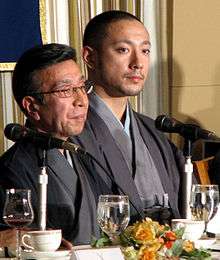Ichikawa Ebizō XI
| Ichikawa Ebizō XI 十一代目市川海老蔵 | |
|---|---|
 Ebizō (on the right) with Danshirō Ichikawa IV, ca. 2007. | |
| Born |
Takatoshi Horikoshi[1] 6 December 1977 Tokyo, Japan |
| Other names | Ichikawa Shinnosuke VII |
| Spouse(s) | Mao Kobayashi |
Ichikawa Ebizō XI (十一代目市川海老蔵 Jūichidaime Ichikawa Ebizō, born December 6, 1977) is the eleventh and current holder of the Ebizō name. He is a famous Kabuki, television and film actor and heir to the prestigious Ichikawa clan of kabuki actors.
Career
The son of Danjūrō XII, he was born in Tokyo and began his career at the age of six in a 1983 play of Genji Monogatari. In 1985 he was bestowed the name Shinnosuke VII and continued to perform in kabuki under this name until 2003. He made his first television appearance in 1994 in the NHK Taiga drama, Hanna no Ran, which starred his father.
In 2002-2003, he had a starring television role as the great samurai, Miyamoto Musashi, in the NHK drama, Musashi. After the series ended, he starred again as the great warrior in a kabuki drama. He would go on to take part in several plays before his name was changed to Ebizō XI in May 2004.
He has appeared in several commercials, and in his first film role, Deguchi no Nai Umi, (Sea With No Exit) in 2006. He toured Europe, Australia[2] and various other prefectures in Japan doing kabuki. In 2007 he was awarded the L'Ordre des Arts et des Lettres after a performance at the Palais Garnier in Paris.[2] A total of twelve performances of Yoshitsune Senbon Zakura by the Shochiku Grand Kabuki featuring Ebizō were held at Sadler's Wells Theatre in London from June 4 to 15, 2010.[3][4]
On November 25, 2010, he was assaulted in the early morning hours while out drinking with Kabuka friends in Tokyo's Nishi-Azabu area. According to the Japanese press, he forced the man to drink tequila from an ashtray.[5] Ebizō returned home, where his wife Mao Kobayashi discovered his wounds, which included a depressed fracture to a cheekbone and severe bruising,[2] and called the police, after which he was rushed to Toranomon Hospital.[6] As a result of the injuries suffered there was speculation that Ebizō may have had to retire, being unable to do the cross-eyed nirami glare important in kabuki leads.[2] Theatre operator Shochiku suspended him from kabuki as a result of the incident.[7]
He starred in Takashi Miike's 2011 3D remake of Hara-Kiri. On July 2, 2011, Ebizõ returned to the stage at the July Grand Kabuki performance at the Shinbashi playhouse in Tokyo.
Starting Jan 9, 2016, and continuing Jan 16, 2016, as a special guest, he played himself in a two-part new year's special of the anime series, Detective Conan.
Personal life
On November 19, 2009, he announced that he was going to marry a newscaster Mao Kobayashi. The two met when he appeared as a guest on her show News Zero.[8] On July 25, 2011, his eldest daughter, Reika, was born. On March 22, 2013, his eldest son and thus successor, Horikoshi Kangen, was born.
See also
- Ichikawa Ebizō - chronology of Ebizo kabuki actors
- Ichikawa Danjūrō - chronology of Danjuro kabuki actors
References
- ↑ While the stage names of all kabuki actors have retained traditional order (Surname-Givenname) on Wikipedia, birth names of those born after the Meiji Restoration are in Western order (Givenname-Surname).
- 1 2 3 4 Ryall, Julian (6 December 2010). "Career of Japan's Brad Pitt could be over after bar brawl". London: Telegraph. Retrieved 2010-12-07.
- ↑ "Information about Kabuki featuring Ebizo Ichikawa XII by Sadler's Wells Theatre". Sadler's Wells-London's Dance House. Retrieved March 24, 2010.
- ↑ "Shochiku Grand Kabuki in London 2010". Shochiku Co.,Ltd. Retrieved March 24, 2010.
- ↑ Ebizo Denies All at Press Conference
- ↑ 「海老蔵さん、顔などけが酒を飲んでいて殴られた」("Ebizō Punched in Face while Drinking")。Asahi Shimbun. 25 November 2010. Retrieved 1 December 2010.
- ↑ Yamaguchi, Mari. "Star of Japan's Kabuki theatre suspended for drunken brawl". CTV. Retrieved 2011-01-11.
- ↑ 「市川海老蔵さんと小林麻央さん結婚へ」 ("Ichikawa Ebizō and Mao Kobayashi to Marry.")。Asahi Shimbun. 19 November 2009. Retrieved 22 November 2009.
External links
- Career Timeline
- NARITAYA Ichikawa Danjuro/Ebizo Official Website
- ABKAI Ichikawa Ebizō XI blog (Japanese)